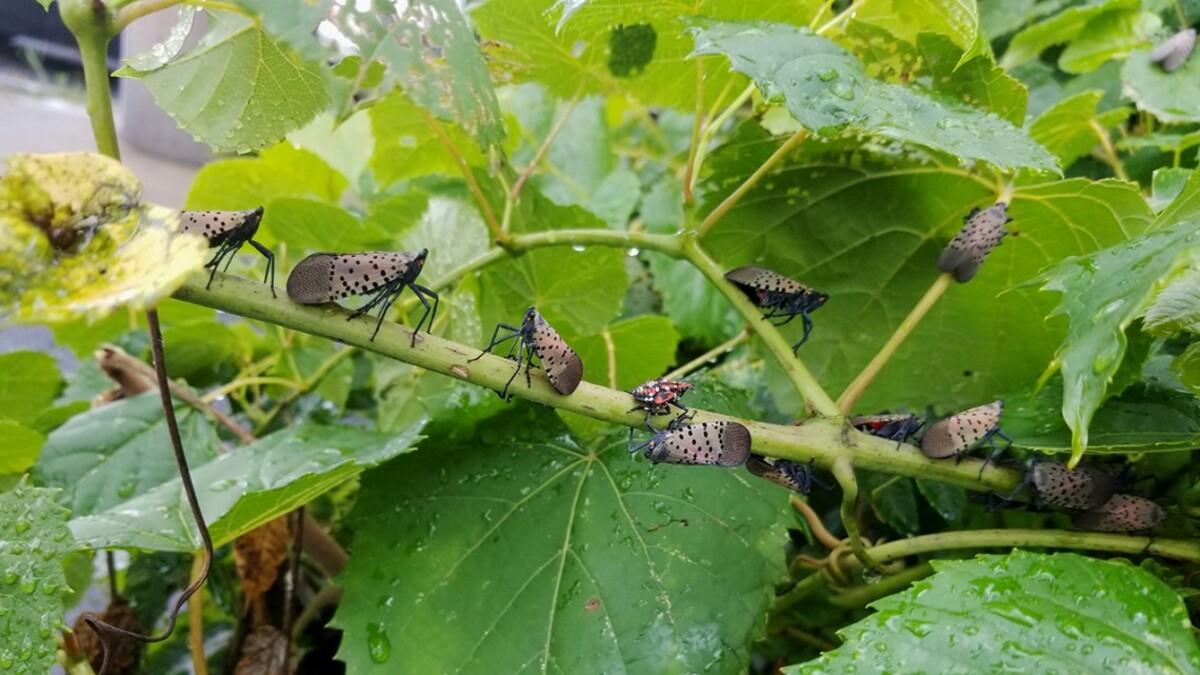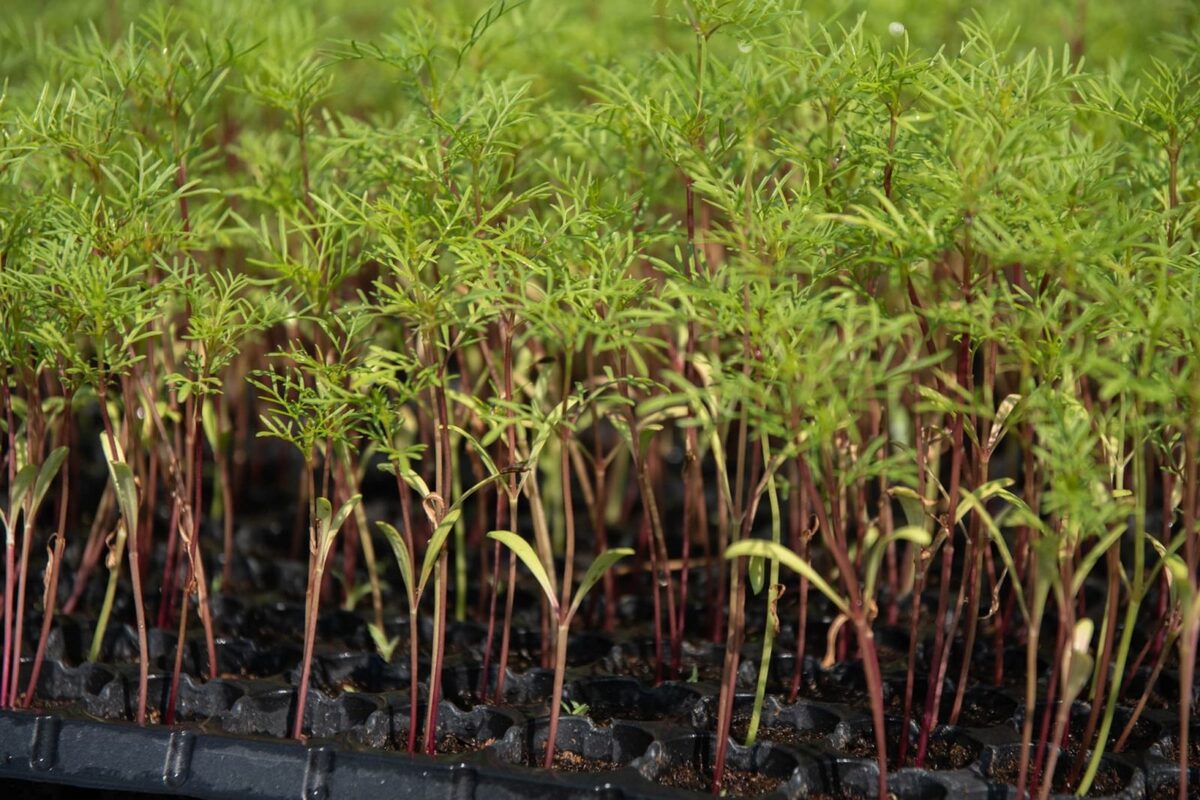Home>Gardening Tips and Tricks>Problem Solving>What Trees Do Lanternflies Like


Problem Solving
What Trees Do Lanternflies Like
Published: November 5, 2023
Discover effective problem solving solutions to protect your trees from lanternflies. Learn what trees these pests are attracted to and how to keep them at bay.
(Many of the links in this article redirect to a specific reviewed product. Your purchase of these products through affiliate links helps to generate commission for Chicagolandgardening.com, at no extra cost. Learn more)
Table of Contents
Introduction
Welcome to the comprehensive guide on the fascinating world of lanternflies and their preference for certain trees. Lanternflies, scientifically known as planthoppers, are a unique insect species that have captured the attention of researchers and nature enthusiasts alike. These insects are known for their vibrant colors and distinct wing patterns, making them a captivating sight in the natural world.
Understanding the preferences of lanternflies when it comes to trees is of great importance. These insects have a significant impact on the health and well-being of the trees they infest. By understanding their preferences, we can better protect and preserve our valuable trees from the potential harm caused by lanternflies.
There are several factors that attract lanternflies to certain trees. By exploring these factors, we can gain insights into the specific characteristics that lanternflies are drawn to. Additionally, we will delve into the impact that lanternflies can have on their preferred trees, and discuss ways in which we can protect our trees from their presence.
So, join us on this journey as we uncover the world of lanternflies and their affinity for particular trees. Let’s explore the intricate relationship between these fascinating insects and the trees they choose as their preferred habitat. Together, we can gain valuable knowledge and take proactive steps to ensure the well-being of our cherished trees.
What are lanternflies?
Lanternflies are a unique type of insect belonging to the Fulgoridae family, commonly known as planthoppers. These insects are known for their striking appearance, featuring brightly colored wings and distinct patterns that make them easily recognizable. Lanternflies are predominantly found in Asia and North America, with various species inhabiting different regions.
The life cycle of a lanternfly consists of several stages, starting with eggs that are laid on the bark of trees or other surfaces. Once the eggs hatch, the nymphs emerge and begin feeding on plant sap. As they grow, they go through several instar stages before reaching adulthood. Adult lanternflies can vary in size, with some species reaching up to two inches in length.
One of the most distinguishing characteristics of lanternflies is their ability to produce honeydew, a sticky secretion that is excreted after feeding on plant sap. The honeydew serves as a food source for other insects, such as ants, and can also lead to the growth of sooty mold on trees and plants.
The invasive species, Spotted Lanternfly (Lycorma delicatula), has gained significant attention in recent years due to its rapid spread and potential harm to agriculture and forestry. Originally from Asia, these lanternflies have made their way to North America and pose a threat to various crops and trees.
While lanternflies may be visually striking, they can have detrimental effects on the environment. Their feeding behavior can weaken and damage trees, making them more susceptible to diseases and other pests. It is crucial to understand how lanternflies interact with trees to effectively mitigate their impact and protect our valuable plant life.
Importance of Understanding Lanternflies’ Preferences
Understanding the preferences of lanternflies when it comes to trees is of utmost importance for several reasons. These insects have the potential to significantly impact the health and well-being of the trees they infest. By gaining insights into their preferences, we can take proactive measures to protect our trees and mitigate the potential damage caused by lanternflies.
One key reason for understanding lanternflies’ preferences is to identify the factors that attract them to certain trees. By studying these factors, we can gain a deeper understanding of the specific characteristics that lanternflies are drawn to. This knowledge allows us to make informed decisions when it comes to selecting tree species for landscaping or reforestation efforts, reducing the likelihood of attracting lanternflies to vulnerable areas.
Furthermore, understanding lanternflies’ preferences can help in identifying the trees that are most at risk from their presence. Certain tree species may be particularly susceptible to lanternfly infestations, making it essential to monitor and protect these trees from potential damage. By focusing efforts on these vulnerable trees, we can optimize resources and prioritize conservation strategies.
The impact of lanternflies on preferred trees extends beyond their immediate health. When lanternflies infest trees, they have the potential to weaken them, making them more susceptible to diseases and other pests. By understanding their preferences, we can better anticipate and address these vulnerabilities, implementing proactive measures to strengthen and protect our trees.
Additionally, knowing which trees lanternflies prefer provides essential information for the agricultural and forestry sectors. Trees that are important for commercial purposes, such as fruit-bearing trees or timber species, may be at a higher risk of lanternfly infestations. By understanding lanternflies’ preferences, farmers and foresters can implement targeted measures to safeguard their crops and industry.
Overall, understanding lanternflies’ preferences is crucial for effective insect management and conservation efforts. By gaining insights into their attraction to specific tree species, we can take proactive measures to protect vulnerable trees and reduce the potential impact of lanternflies on our ecosystems. This knowledge empowers us to make informed decisions and develop strategies to preserve the health and diversity of our valuable tree populations.
Factors that Attract Lanternflies to Trees
Lanternflies are attracted to trees based on several factors that influence their feeding and breeding behaviors. Understanding these factors can provide valuable insights into why lanternflies are drawn to certain trees and how we can better protect our vegetation from their presence.
One key factor that attracts lanternflies to trees is the availability of the sap they feed on. Lanternflies have a piercing mouthpart that allows them to extract sap from trees, which serves as their primary source of nutrition. Trees that produce abundant sap are more likely to attract lanternflies, as they provide a reliable food source for these insects.
The appearance and physical characteristics of trees are also influential in lanternflies’ attraction. Research suggests that lanternflies are visually attracted to certain colors and patterns. Brightly colored trees or trees with unique visual markers may be more appealing to lanternflies and draw them in. Similarly, trees with distinctive shapes or structures might catch the attention of these insects.
Another factor that plays a role in lanternflies’ attraction to trees is the presence of volatile compounds emitted by certain tree species. These volatile compounds, known as semiochemicals, can act as attractants for lanternflies. Some tree species release specific volatile compounds that are highly attractive to lanternflies, luring them to the vicinity.
Furthermore, the proximity of certain trees to other lanternfly-infested trees can also influence their attraction. Lanternflies are known to aggregate and form large groups, making them highly mobile. Trees located near infested areas may be more susceptible to lanternfly attraction due to the presence of these aggregations.
Lastly, the time of year and seasonal changes can impact lanternflies’ attraction to trees. During their reproductive periods, lanternflies are more likely to seek out suitable habitats for mating and laying eggs. Understanding the seasonal patterns and life cycle of lanternflies can help predict their attraction to trees at specific times of the year.
By considering these various factors that attract lanternflies to trees, we can develop targeted strategies to minimize their impact. Implementing techniques such as pheromone trapping, proper tree species selection, and management practices can help reduce the attraction of lanternflies to vulnerable areas and mitigate the potential damage caused by their presence.
Trees that Lanternflies Prefer
Lanternflies have certain tree preferences that make them more likely to infest and feed on specific species. Understanding which trees lanternflies prefer can help us better protect vulnerable areas and develop targeted strategies for mitigating their impact on our valuable vegetation.
One tree species that lanternflies are particularly attracted to is the tree-of-heaven (Ailanthus altissima). This invasive tree species, known for its rapid growth and ability to thrive in various conditions, is a preferred host for lanternflies. Tree-of-heaven provides an abundant food source for lanternflies due to its high sap content and nutritional value.
Along with the tree-of-heaven, lanternflies may also show a preference for other species in the deciduous tree family. Trees such as maple (Acer spp.), walnut (Juglans spp.), and poplar (Populus spp.) have been observed to attract lanternflies, potentially due to their sap characteristics or visual appeal.
Certain fruit-bearing trees are also on the list of preferred hosts for lanternflies. Trees such as apple (Malus spp.), peach (Prunus persica), and grapevine (Vitis spp.) have been known to attract lanternflies. The sugary sap produced by these trees, along with the fruit itself, provides lanternflies with an abundant food source.
It is essential to note that lanternflies may not show a preference for all individuals of a particular tree species. Factors such as tree health, sap flow, and environmental conditions can influence their attractiveness to lanternflies. However, these preferred tree species serve as important indicators for potential lanternfly infestations, and extra caution should be taken when monitoring and protecting them.
It is important to keep in mind that while lanternflies may prefer certain tree species, they can still feed on and infest other trees in their vicinity. Therefore, it is crucial to employ comprehensive management strategies that consider the potential risk to both preferred and non-preferred tree species.
By understanding the tree species that lanternflies prefer, we can focus our efforts on monitoring and protecting these vulnerable trees. Implementing measures such as tree removal, insecticide treatments, and targeted monitoring programs can help minimize the impact and spread of lanternfly infestations, thus safeguarding the health and diversity of our tree populations.
Impact of Lanternflies on Preferred Trees
Lanternflies can have a significant impact on the health and well-being of their preferred trees. Understanding this impact is crucial for implementing effective management strategies and preserving the vitality of our valuable vegetation.
One of the main impacts of lanternflies on preferred trees is their feeding behavior. Lanternflies have a piercing mouthpart that allows them to extract sap from the trees they infest. This continuous sap extraction weakens the trees, making them more susceptible to diseases, fungal infections, and other pests. The prolonged feeding by lanternflies can lead to reduced tree vigor, stunted growth, and even death in severe cases.
The honeydew secretion produced by lanternflies can also have negative consequences for preferred trees. Honeydew is a sticky substance excreted by lanternflies after feeding on sap, and it can accumulate on the leaves and branches of trees. This sticky coating can attract other insects, such as ants, and provide a medium for the growth of sooty mold. Sooty mold can inhibit photosynthesis and further weaken the tree’s health.
Furthermore, lanternflies’ attraction to preferred trees can result in increased competition for resources. As these insects congregate and infest certain tree species, they deplete the available sap and nutrients, leaving less for the tree to support its growth and development. This competition for resources can exacerbate the stress on preferred trees and hinder their ability to withstand other environmental pressures.
It is also important to consider the indirect impacts of lanternfly infestations on preferred trees. When a tree becomes weakened and vulnerable due to lanternfly feeding, it becomes more susceptible to other pests and diseases. The compromised state of the tree makes it an attractive target for secondary infestations, which can further compromise its health and increase the risk of mortality.
Moreover, the visual and aesthetic appeal of preferred trees can be significantly diminished by lanternfly infestations. The presence of large numbers of lanternflies on trees can create an unsightly appearance, with clusters of insects and sticky honeydew residue. This can negatively impact the overall visual aesthetic of parks, gardens, and other natural areas where these trees are prevalent.
By understanding the impact of lanternflies on preferred trees, we can prioritize management efforts to protect and mitigate the damage caused by these infestations. Implementing measures such as tree health assessments, targeted monitoring programs, and effective pest control strategies can help minimize the impact of lanternflies and maintain the health and beauty of our preferred tree species.
Ways to Protect Trees from Lanternflies
Protecting trees from lanternfly infestations is crucial to safeguard their health and maintain the biodiversity of our ecosystems. By implementing proactive measures, we can reduce the impact of lanternflies and preserve the vitality of our valuable trees. Here are several effective strategies for protecting trees from lanternflies:
1. Tree species selection: When planting new trees, choose species that are less preferred by lanternflies. By diversifying the tree species in an area, we can minimize the risk of attracting large numbers of lanternflies to a specific location.
2. Monitoring and early detection: Regularly inspect trees for signs of lanternfly infestations. Look for the presence of nymphs, adult lanternflies, or the characteristic egg masses on tree trunks and branches. Early detection allows for prompt intervention to prevent infestations from spreading.
3. Physical barriers: Install physical barriers, such as sticky bands or netting, around tree trunks to prevent lanternflies from climbing up and reaching the foliage. Regularly inspect and clean these barriers to ensure their effectiveness.
4. Remove egg masses: Scrape off lanternfly egg masses from tree bark and other surfaces using a credit card or similar tool. Destroying the egg masses helps reduce the population of emerging nymphs and prevents further infestations.
5. Biological control: Introduce natural predators and parasites of lanternflies, such as certain species of wasps or fungi, into the ecosystem. These biological control agents can help regulate lanternfly populations naturally, reducing their impact on trees.
6. Chemical control: In severe infestations, insecticide treatments may be necessary. Consult with local agricultural or pest management authorities for appropriate insecticide options and application techniques. Always follow label instructions and apply pesticides responsibly.
7. Community involvement: Educate and engage the community in lanternfly awareness and prevention programs. Encourage residents and businesses to report lanternfly sightings and participate in eradication efforts. Collaborative community action can significantly enhance the effectiveness of lanternfly control measures.
8. Support research and regulations: Stay informed about the latest research on lanternflies and support regulations aimed at preventing their spread. Stay updated on quarantines and restrictions in your area to prevent unintentional transportation of lanternflies to new locations.
Implementing a combination of these strategies can help protect trees from lanternfly infestations and minimize their impact. Regular monitoring, early intervention, and community involvement are key in effectively managing and preventing the spread of lanternflies, preserving the health and beauty of our trees for future generations.
Conclusion
Understanding the preferences and behaviors of lanternflies when it comes to trees is crucial for effectively managing their impact and protecting our valuable vegetation. Through this comprehensive guide, we have explored various aspects of lanternfly-tree dynamics and the measures we can take to mitigate their presence.
Lanternflies are fascinating insects known for their vibrant colors and distinct wing patterns. However, their feeding behavior can weaken and damage trees, making them more susceptible to diseases, pests, and environmental stressors. By understanding the factors that attract lanternflies to trees, such as sap availability, visual appeal, and volatile compounds, we can make informed decisions to minimize their attraction and protect vulnerable areas.
Preferred tree species, such as the tree-of-heaven and various fruit-bearing trees, are particularly susceptible to lanternfly infestations. Monitoring the health of these trees and implementing proactive measures, such as physical barriers, early detection, and biological control, can help minimize the impact of lanternflies and preserve the well-being of these preferred trees.
It is also important to recognize the indirect impacts of lanternfly infestations, such as increased vulnerability to secondary pests and diseases. By taking a comprehensive approach to tree protection, including diversifying tree species, supporting research efforts, and fostering community involvement, we can effectively manage lanternflies and reduce their impact on our ecosystems.
Protecting trees from lanternflies is not only essential for preserving biodiversity but also for maintaining the aesthetic value and environmental benefits that trees provide. By implementing these strategies and staying informed about the latest research and regulations, we can ensure that our trees thrive and continue to enrich our natural surroundings.
Let us work together to protect our valuable trees from lanternfly infestations, promote sustainable management practices, and preserve the beauty and ecological balance of our precious natural world.








